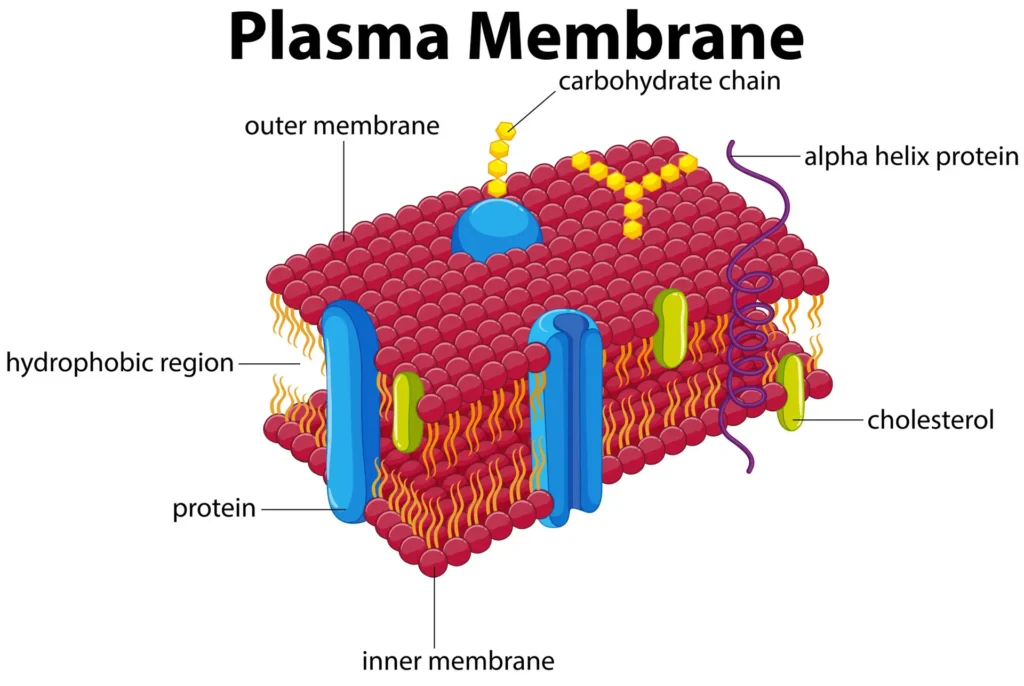The Plasma Membrane
The plasma membrane, also known as the cell membrane, is a crucial component of all living cells. It acts as a protective barrier that regulates the movement of substances in and out of the cell. Composed primarily of a phospholipid bilayer, the plasma membrane is responsible for maintaining the cell’s internal environment, allowing essential molecules to enter while keeping harmful substances out. This selective permeability is key to the proper functioning of cells, supporting processes such as communication, energy transfer, and metabolism.
Structure of the Plasma Membrane
The plasma membrane is primarily made up of a phospholipid bilayer with embedded proteins, cholesterol, and carbohydrates. These components work together to provide the membrane with its semi-permeable nature and flexible structure.
- Phospholipid Bilayer:
- The phospholipid bilayer forms the foundation of the plasma membrane. Each phospholipid molecule has a hydrophilic head (water-attracting) and two hydrophobic tails (water-repelling). The heads face outward toward the water-rich environments inside and outside the cell, while the tails face inward, away from water, forming a barrier.
- Membrane Proteins:
- Embedded within the phospholipid bilayer are various membrane proteins. These proteins serve different functions, such as facilitating the transport of molecules, acting as enzymes, or transmitting signals between the cell and its environment.
- There are two types of membrane proteins:
- Integral Proteins: These proteins span the entire bilayer and are involved in transporting molecules across the membrane.
- Peripheral Proteins: These are attached to the surface of the membrane and are often involved in signaling and maintaining the cell’s shape.
- Cholesterol:
- Cholesterol molecules are interspersed within the phospholipid bilayer and help maintain the fluidity of the membrane. They ensure that the membrane is not too rigid in cold temperatures and not too fluid in warm temperatures, contributing to membrane stability.
- Carbohydrates:
- Carbohydrates attach to proteins or lipids on the outer surface of the membrane, forming glycoproteins and glycolipids. These carbohydrate chains play a key role in cell recognition and communication, as well as helping cells adhere to each other.
Functions of the Plasma Membrane
The plasma membrane is responsible for several critical functions that support the survival and function of the cell:
- Selective Permeability:
- One of the plasma membrane’s key roles is regulating what enters and exits the cell. It selectively allows certain substances to pass through while blocking others. This ensures essential molecules like nutrients and ions enter the cell, while waste products and harmful substances stay out.
- Transport of Molecules:
- Passive Transport: This process does not require energy and allows molecules to move across the membrane through diffusion, moving from areas of high concentration to areas of low concentration. Examples include simple diffusion, facilitated diffusion, and osmosis (the diffusion of water).
- Active Transport: Active transport requires energy (usually in the form of ATP) to move molecules against their concentration gradient. Protein pumps and endocytosis are examples of active transport mechanisms that help maintain the cell’s internal environment.
- Cell Communication:
- The plasma membrane is involved in cell signaling, allowing cells to communicate with each other and respond to their environment. Receptor proteins on the membrane bind to signaling molecules (such as hormones), triggering a response within the cell. This process is essential for coordinating activities such as growth, immune responses, and metabolic processes.
- Cell Adhesion:
- The plasma membrane facilitates the adhesion of cells to one another, which is important for the formation of tissues and organs. Specialized proteins on the surface of the membrane, such as cadherins and integrins, allow cells to stick together and communicate.
- Protection and Structural Support:
- The plasma membrane provides a protective barrier that shields the cell from harmful environmental conditions. It also helps maintain the cell’s shape and structure by interacting with the cytoskeleton (the network of fibers within the cell).
Importance in Health and Disease
The proper functioning of the plasma membrane is essential for maintaining cellular health. When the plasma membrane is damaged or its permeability is altered, it can lead to serious health issues:
- Cystic Fibrosis:
Mutations in a gene that affects a protein responsible for regulating chloride ions in and out of cells cause cystic fibrosis. This defect in membrane transport leads to thick mucus buildup in organs like the lungs and pancreas, resulting in severe respiratory and digestive issues.
- Diabetes:
- In diabetes, the signaling pathway for insulin, which involves receptor proteins on the plasma membrane, is impaired. This affects the cell’s ability to take up glucose from the bloodstream, leading to elevated blood sugar levels.
- Cancer:
- Changes in cell signaling pathways and the expression of membrane proteins can contribute to the uncontrolled growth of cells, a hallmark of cancer. Targeting specific membrane proteins is a common strategy in cancer treatment
